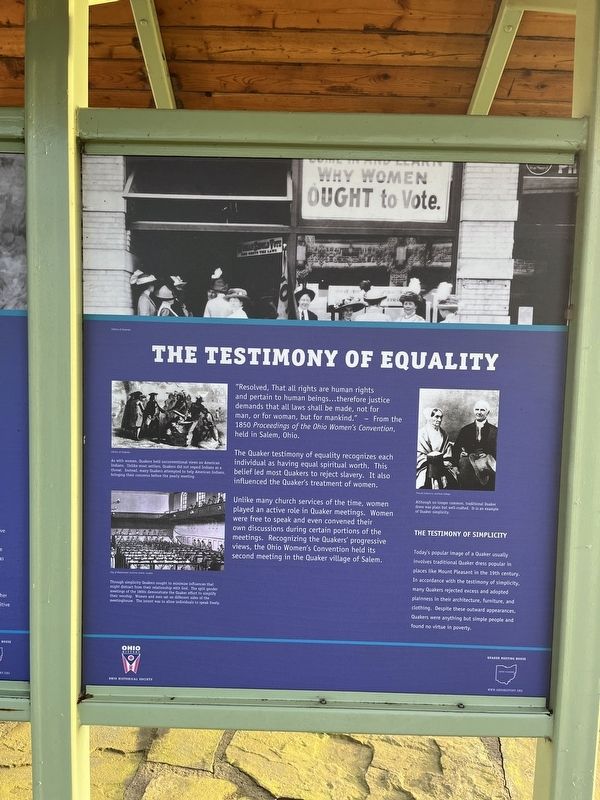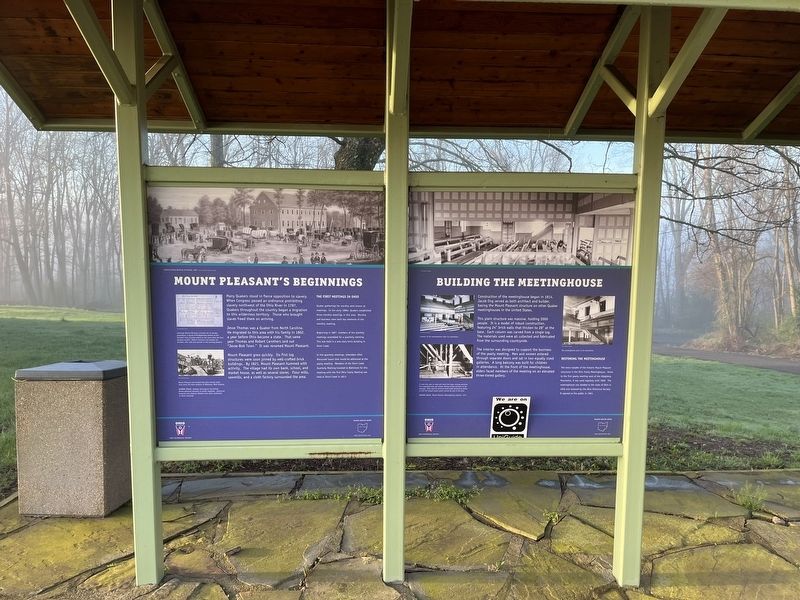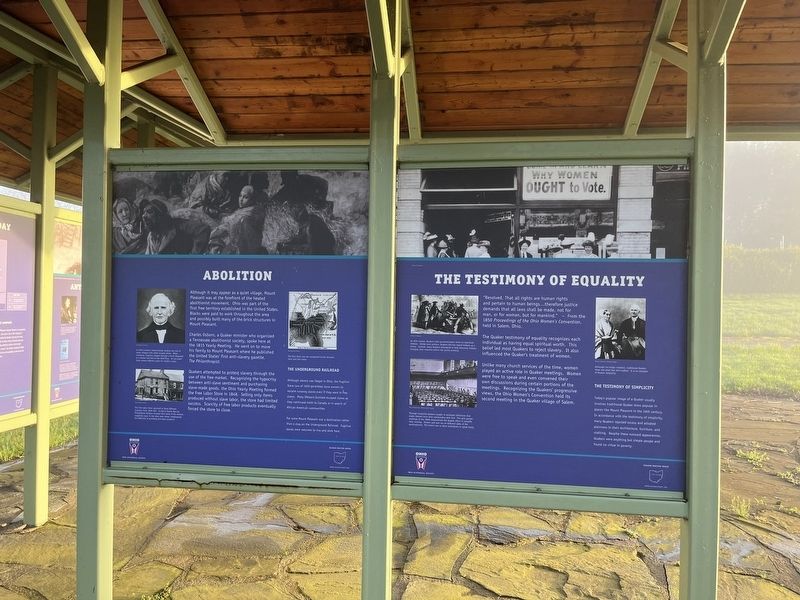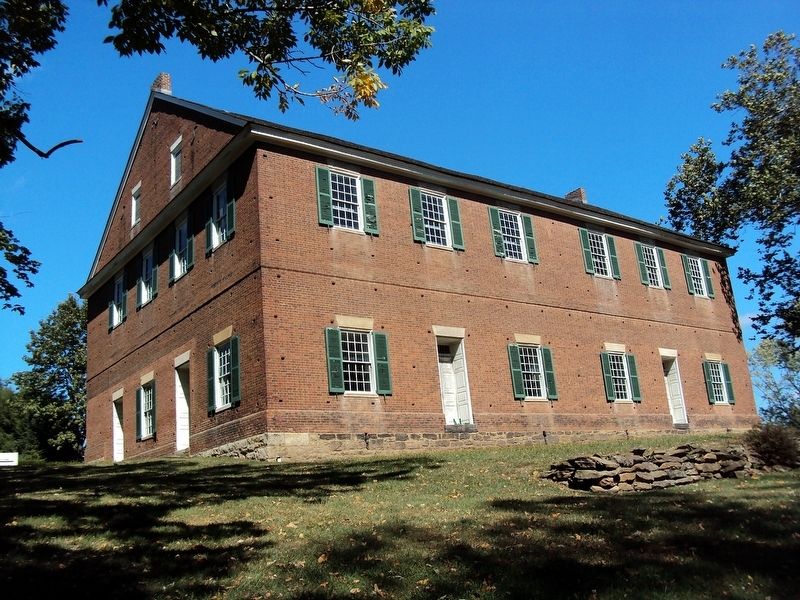Mount Pleasant in Jefferson County, Ohio — The American Midwest (Great Lakes)
Mount Pleasant's Beginnings / The Testimony of Equality

Photographed By Devry Becker Jones (CC0), April 22, 2022
1. Mount Pleasant's Beginnings side of the marker
Mount Pleasant's Beginnings
Many Quakers stood in fierce opposition to slavery. When Congress passed an ordinance prohibiting slavery northwest of the Ohio River in 1787, Quakers throughout the country began a migration to this wilderness territory. Those who brought slaves freed them on arriving.
Jesse Thomas was a Quaker from North Carolina. He migrated to this area with his family in 1802, a year before Ohio became a free state. That same year Thomas and Robert Carothers laid out “Jesse-Bob Town.” It was renamed Mount Pleasant.
Mount Pleasant grew quickly. Its first log structures were soon joined by well-crafted brick buildings. By 1821, Mount Pleasant hummed with activity. The village had its own bank, school, and market house, as well as several stores. Flour mills, sawmills, and a cloth factory surrounded the area.
[Sidebar:]
The First Meetings in Ohio
Quaker gatherings for worship were known as meetings. In the early 1800s, Quakers established three monthly meetings in this area. Worship and business were both key elements of the monthly meeting.
Beginning in 1807, members of the monthly meetings assembled for a quarterly meeting. This was held in a one-story brick building in Short Creek.
In the quarterly meetings, attendees often discussed issues that would be addressed at the yearly meeting. Members of the Short Creek Quarterly Meting traveled to Baltimore for this meeting until the first Ohio Yearly Meeting was held at Short Creek in 1813.
[Captions:]
Although Mount Pleasant is known for its Quaker population, a group of Presbyterians known as the Seceders were already settled in this area when the first Quakers arrived. Robert Carothers was among the Seceders who sold land parcels to the arriving Quakers.
Mount Pleasant was located less than twenty miles away from the slave markets in Wheeling, West Virginia
Banner image: Quakers throughout the United States gathered annually at yearly meetings. Important business and religious debates were often conducted at these meetings.
The Testimony of Equality
"Resolved, That all rights are human rights and pertain to human beings…therefore justice demands that all laws shall be made, not for man, or for woman, but for mankind." — From the 1850 Proceedings of the Ohio Women’s Convention held in Salem, Ohio.
The Quaker testimony of equality recognizes each individual as having equal spiritual worth. This belief led most Quakers to reject slavery. It also influenced the Quaker's treatment of women.
Unlike

Photographed By Devry Becker Jones (CC0), April 22, 2022
2. The Testimony of Equality side of the marker
[Sidebar:]
The Testimony of Simplicity
Today's popular image of a Quaker usually involved traditional Quaker dress popular in places like Mount Pleasant in the 19th century. In accordance with the testimony of simplicity, many Quakers rejected excess and adopted plainness in their architecture, furniture, and clothing. Despite these outward appearances, Quakers were anything but simple people and found no virtue in poverty.
[Captions:]
As with women, Quakers held unconventional views on American Indians. Unlike most settlers, Quakers did not regard Indians as a threat. Instead, many Quakers attempted to help American Indians, bringing their concerns before the yearly meeting.
Through simplicity Quakers sought to minimize influences that might distract from their relationship with God. The split gender meetings of the 1800s demonstrate the Quaker effort to simplify their worship. Women and men sat on different sides of the meetinghouse. The intent was to allow individuals to speak

Photographed By Devry Becker Jones (CC0), April 22, 2022
3. Mount Pleasant's Beginnings / The Testimony of Equality Marker
Although no longer common, traditional Quaker dress was plain but well-crafted. It is an example of Quaker simplicity.
Erected by Ohio Historical Society.
Topics and series. This historical marker is listed in these topic lists: Churches & Religion • Civil Rights • Native Americans • Settlements & Settlers • Women. In addition, it is included in the Ohio Historical Society / The Ohio History Connection, and the Quakerism series lists. A significant historical year for this entry is 1787.
Location. 40° 10.417′ N, 80° 48.176′ W. Marker is in Mount Pleasant, Ohio, in Jefferson County. Marker is at the intersection of Market Street and South Street on Market Street. Touch for map. Marker is at or near this postal address: 298 Market St, Mount Pleasant OH 43939, United States of America. Touch for directions.
Other nearby markers. At least 8 other markers are within walking distance of this marker. Building the Meetinghouse / Abolition (here, next to this marker); Mount Pleasant Today / What Is A Quaker? (here, next to this marker); Anti-Slavery Pioneer / Schisms (here, next to this marker); Quakers and Wars During the 1900s / Quakers and the Civil War (here, next to this marker); Samuel Gill House (about 500 feet away, measured in a direct line); Benjamin Lundy Home / Free Labor Store

Photographed By Devry Becker Jones (CC0), April 22, 2022
4. Mount Pleasant's Beginnings / The Testimony of Equality Marker
Credits. This page was last revised on April 23, 2022. It was originally submitted on April 23, 2022, by Jamie Abel of Westerville, Ohio. This page has been viewed 98 times since then and 7 times this year. Photos: 1, 2, 3, 4. submitted on April 23, 2022, by Devry Becker Jones of Washington, District of Columbia. 5. submitted on October 18, 2010, by Jamie Abel of Westerville, Ohio. • Devry Becker Jones was the editor who published this page.
